Technologies
11 New iPhone Feature You Should Be Using if You’re Not Already
Every iPhone owner should know about these iOS features.
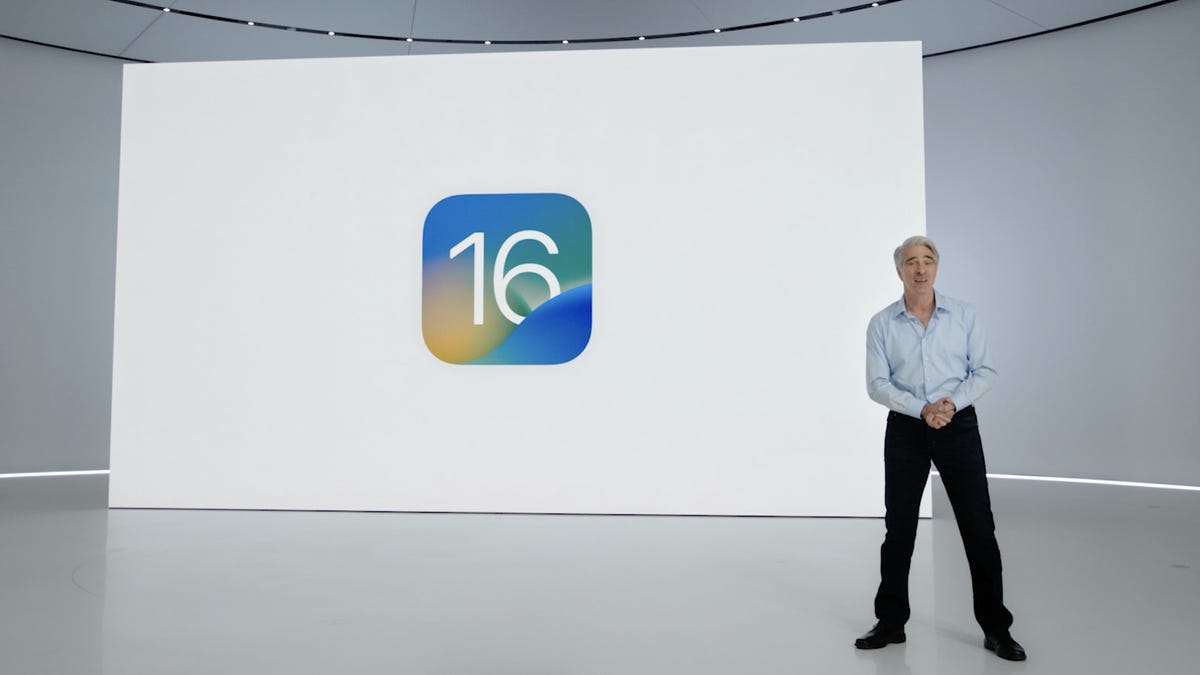
This story is part of Focal Point iPhone 2023, CNET’s collection of news, tips and advice around Apple’s most popular product.
Apple’s iPhone software just keeps getting better. With iOS 16.3, first released in January, Apple adds a number of small but significant updates to the iOS 16 iPhone software, including security keys for iCloud and new wallpaper options. A smaller iOS 16.3.1 update in February then threw in a few bug fixes and security updates as well. And now, the release of iOS 16.4 and its new emojis are just around the corner.
All of these updates continue to add onto Apple’s iOS 16, which first came out in September for anyone with a compatible iPhone. Installing the operating system software on your iPhone gives you new features and settings, such as a more customizable lock screen, a way to edit sent messages and a magic photo editing tool. Plus, iOS 16 brings back the battery percentage icon.
iOS 16 was announced last spring at Apple’s WWDC conference prior to its public launch alongside the iPhone 14. If you’re curious about what else iOS 16 offers, read on as we break down the 11 best new features on your iPhone. Just make sure you’ve already completed these three steps first, and check out the lesser-known features lurking in iOS 16 too.
The ability to edit and ‘unsend’ messages
«Embarrassing typos are a thing of the past,» Craig Federighi, Apple’s senior vice president of software engineering, said at WWDC as he introduced three of the most requested features for the Messages app.
First, in iOS 16 you’ll be able to edit sent messages. So if you notice a typo after a message, you’ll be able to edit the message after the fact. A tiny «edited» appears in the status under the message.
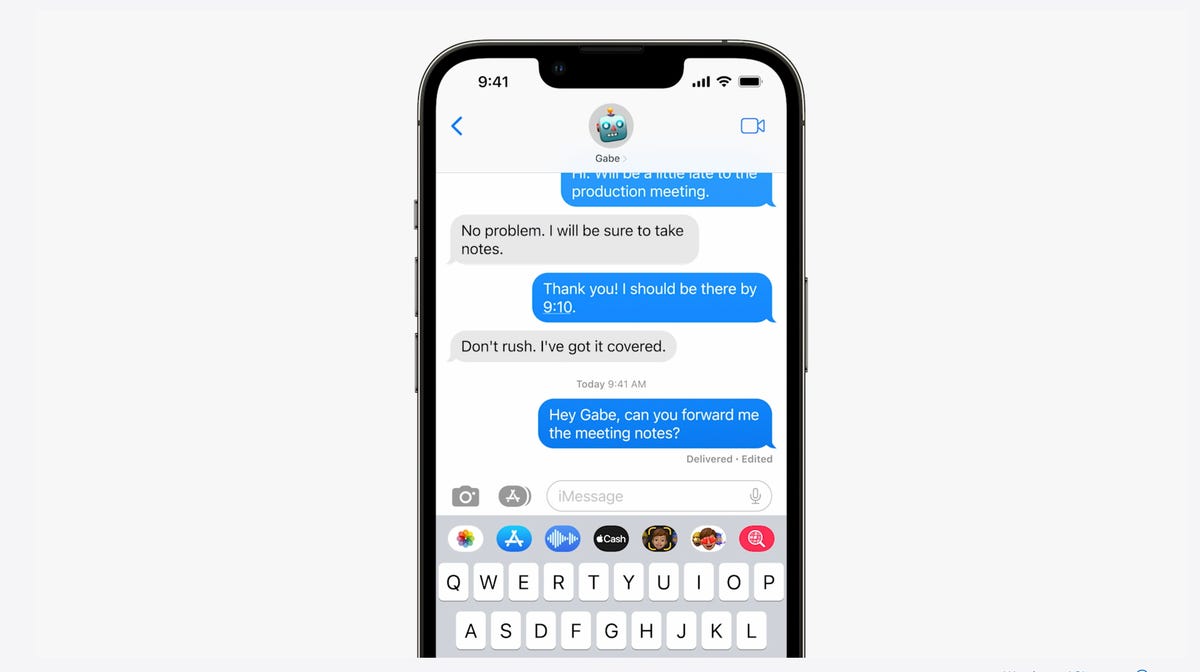

In Messages, you can edit previously sent messages.
AppleNext, and this might be my favorite new feature, you can immediately recall a sent message. If you accidentally send an unfinished message, you can use the Undo Send tool to prevent it from being read and hopefully look less chaotic to your friends and family.
Last, you can mark messages and threads as unread. This could be an excellent tool for when you don’t have time to respond to a message in the moment, but want to make sure you come back to it later.
A new customizable lock screen
One of the things you look at the most on your iPhone is the lock screen, especially if you have a Face ID-equipped iPhone. iOS 16 brings the most substantial update to the iPhone’s lock screen yet. Press and hold to edit your lock screen. You can swipe to try out several different styles. Each style changes the color filter for the background photo and the font on the lock screen so everything complements each other. This feels a bit like Apple’s take on Google’s Material You, which launched with Android 12.
You can also customize the fonts for the time and date, and add lock screen widgets like temperature, activity rings and a calendar. The widgets are akin to complications on the Apple Watch lock screen.
Your iPhone will become more customizable in iOS 16. You’ll be able to choose how your lock screen looks, down to the font and color.
AppleYou can even set up multiple customized lock screens with different widgets and easily swipe to switch between them. There’s also a photo shuffle option that automatically changes the pictures on your lock screen.
One feature we’d been hoping to see Apple add was an always-on display. It’s something nearly all Android phones have; even the Apple Watch does. Well, with the new iPhone 14 Pro and iPhone 14 Pro Max, the always-on display has finally arrived.
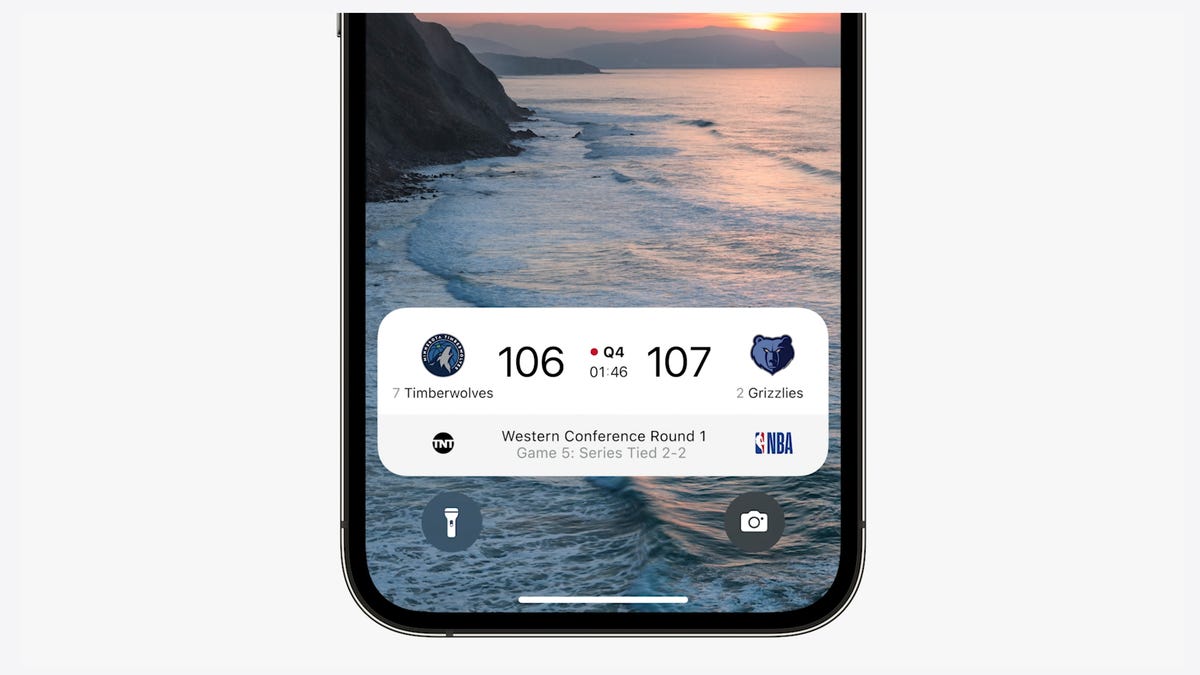

iOS 16 adds a feature that developers can use called Live Activities. This is essentially a mini view of the real-time progress of a workout, sporting event or Uber ride from your iPhone’s lock screen.
AppleNotifications and live activities
Sometimes notifications can cover up your lock screen’s photo, so iOS 16 moves notifications to the bottom of your display. As you receive them, instead of being compiled into a list, they appear like a vertical carousel. This not only looks better but should be a big help for one-handed use of your iPhone.
iOS 16 also aims to solve another notification problem. Sometimes you get a bunch of notifications in a row from one app, like the score of a basketball game. A new tool for developers called Live Activities makes it easier to stay on top of things happening in real time from your lock screen, instead of getting a series of interruptions.
Live Activities should make it easier to follow sporting events, workouts or even the progress of an Uber ride.
Skip CAPTCHAs using Private Access Tokens
The CAPTCHA — which stands for Completely Automated Public Turing test to tell Computers and Humans Apart — has been a necessary evil across the internet. CAPTCHAs are designed to make sure that a person is accessing a website or service, and not a bot. I find them annoying, as they often involve reading strangely written letters or having to find all the images that have a truck. With iOS 16, Apple plans to start replacing these awkward interactions with Private Access Tokens.
According to a video on Apple’s website demonstrating Private Access Tokens, websites that support the token will essentially log in and authenticate that you are indeed a human without your having to play any of the usual CAPTCHA games. Apple says in the video that the company is working with other companies to roll out support for this feature, so we can’t say the CAPTCHA will be dead after iOS 16 rolls out to the public. But the concept could provide some relief if it gets adopted.
Wallet and Apple Pay Later
ID cards from more states will be available in your Wallet app along with more security and privacy features. In iOS 16 you can also protect your identity and age. So rather than showing your exact birth date, the Wallet app will display your ID and that you’re over 21.
iOS 16 makes sharing keys easier with apps like Mail and Messages. When your friend receives the key, they can add it to the Wallet app on their iPhone. Apple said it’s working to make sure that shared keys are an industry standard and free for others.
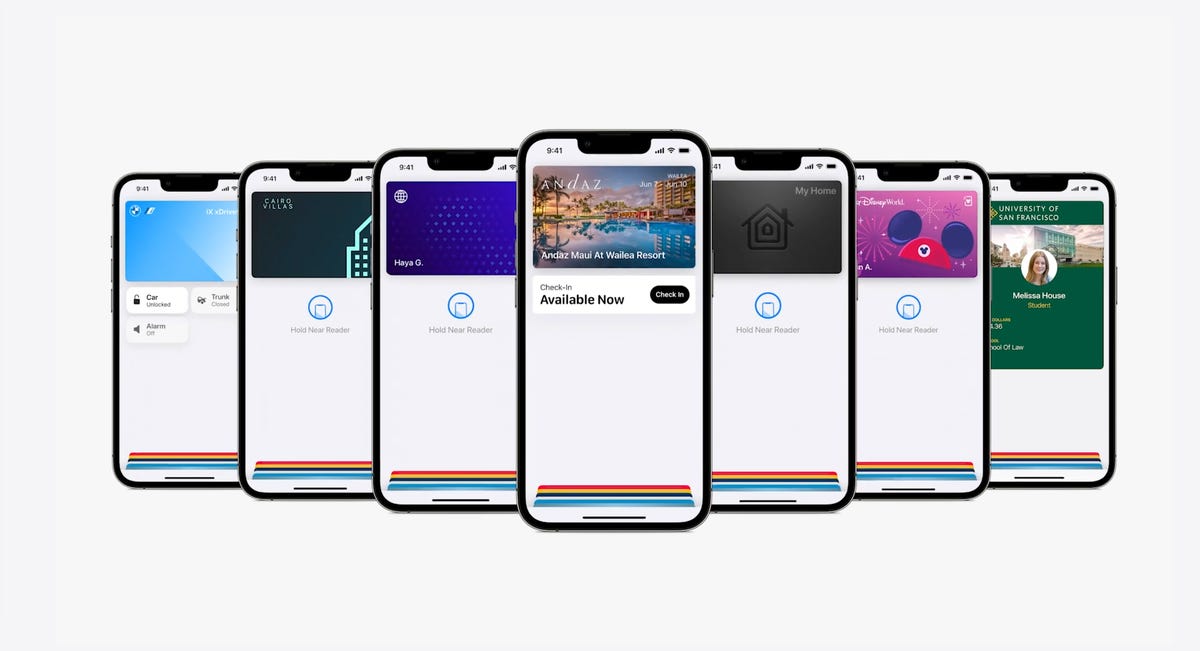

The Wallet app in iOS 16 gets a bunch of small but notable updates, including the Apple Pay Later payment plan.
AppleApple Pay will support new types of payments and adds a new feature called Apple Pay Later, a Klarna-like service that lets you split the cost of an Apple Pay purchase into four equal payments spread over six weeks, with zero interest and no fees. Upcoming payments are managed through the Wallet app, making it easy to keep track of dates and payments.
But Apple Pay doesn’t stop there. A new feature will also help you track Apple Pay orders and lets merchants deliver detailed receipts and tracking information. This should make it easier to stay up to date on the status of all your orders.
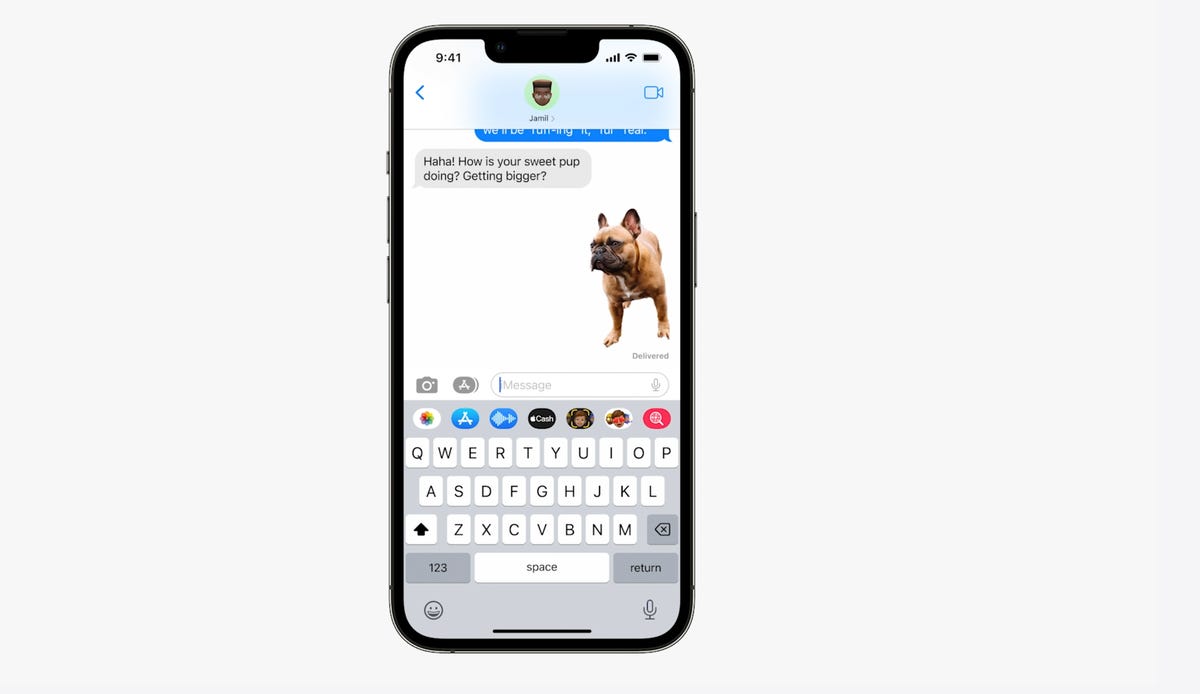

You can tap and hold on the subject of a photo and separate it from the background. Then you can drag it into another app like Messages to share it.
AppleVisual Look Up’s tap and drag for photos
In iOS 15, Visual Look Up analyzes your photos and can identify objects like plants, landmarks and pets. iOS 16 takes this to the next level. When you touch a photo’s subject like the dog in the image above, you can lift it away from the background and add it to apps like Messages. Essentially it’s a tap-and-hold tool that removes a photo’s background.
Apple sometimes overuses the word «magic,» but this feature truly seems like it.
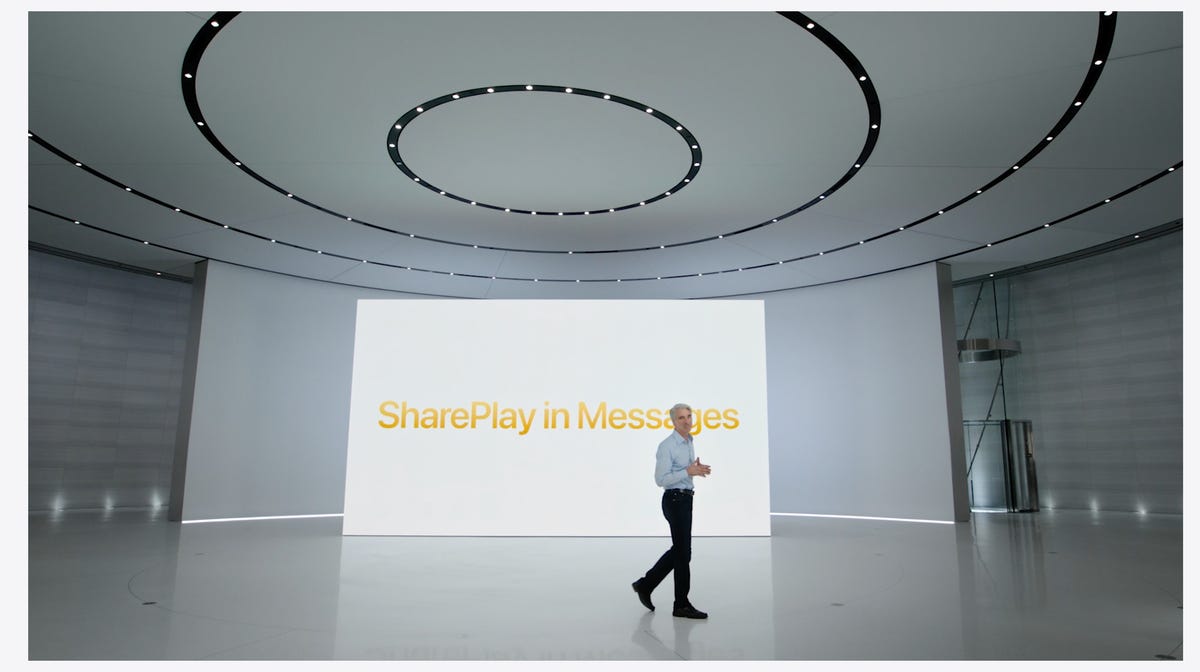

During the keynote for WWDC, Apple executive Craig Federighi introduces SharePlay for the Messages app.
AppleSharePlay comes to Messages
SharePlay, which debuted in iOS 15, lets you have a shared experience while connecting with someone over FaceTime. You can watch TV shows, listen to music in sync and other things. iOS 16 adds the ability to discover more apps that support SharePlay from within FaceTime.
But perhaps one of the coolest things Apple did for SharePlay was to make it work within the Messages app. Apple said that this was one of the biggest requests from app developers. Now when you want to share a movie on Disney Plus, you can start SharePlay together with a friend while chatting in Messages.
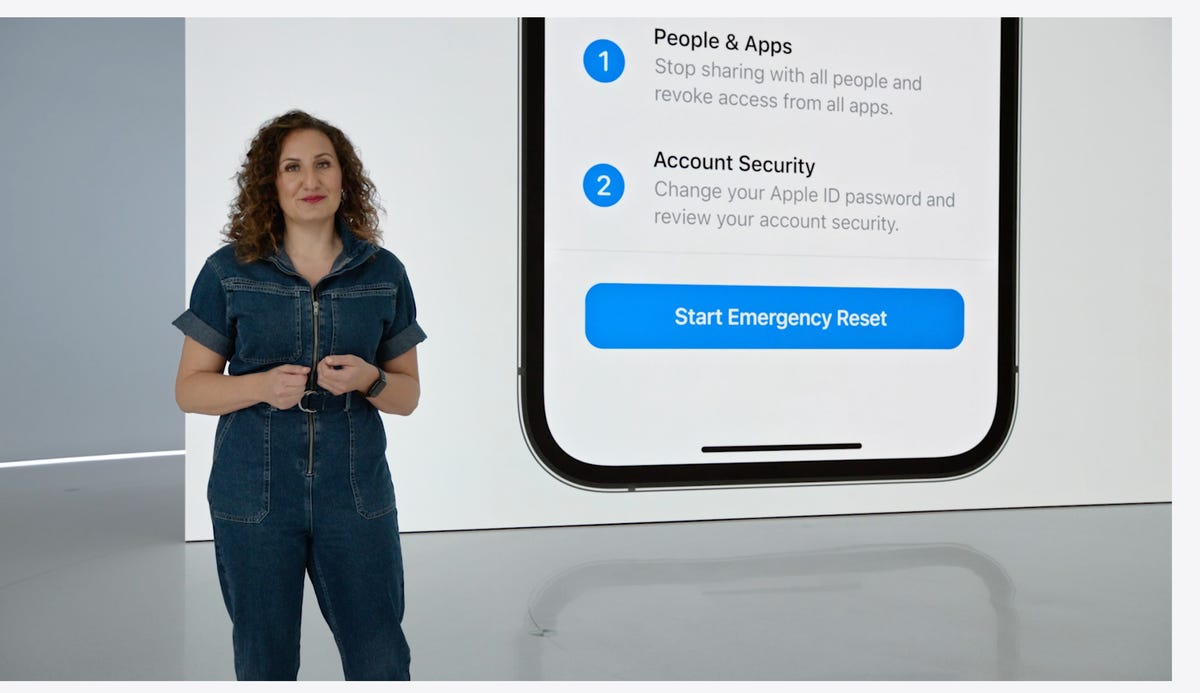

Safety Check lets you quickly reset location sharing and access to passwords. It’s intended to be helpful for people in abusive relationships.
AppleSafety Check aims to help people in abusive relationships
Safety Check is a new feature intended to be helpful for people in abusive relationships. It lets you review and reset who has access to location information as well as passwords, messages and other apps on an iPhone.
Focus mode updates and Focus filters
Focus mode gets several updates. The first applies Focus behaviors to widgets and lock screen looks. So you could have one lock screen set for when your Work Focus is enabled and another for workouts.
Apple added specific Focus filters that apply your iPhone’s Focus mode within apps. For example, in Safari, you can limit what tabs are shown depending on what Focus mode you have active.
Apple Maps adds transit fare cards
Maps gets several updates. You’ll be able to plan trips with up to 15 different stops along the way. If you start planning a trip with the Maps app on your Mac, you’ll be able to share that to your iPhone.
And in something similar to what Google announced for Google Wallet in Android 13, you’ll be able to see transit fare estimates as well as add more money to a fare card from within Apple Maps.
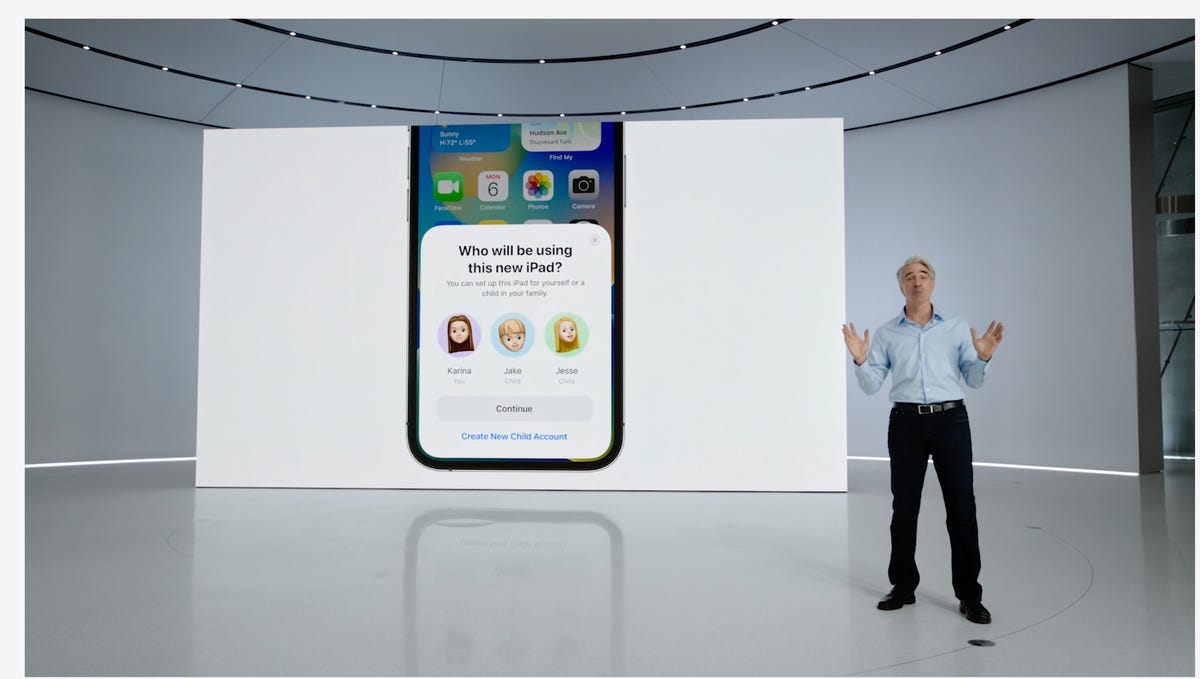

In iOS 16 you’ll be able to customize Quick Start with a specific child’s iCloud parental controls and settings.
AppleiCloud family checklist
iCloud gets several new features. One of the more interesting ones is the option to quickly set up a new device for your child. When Quick Start appears, you have the option to pick a user for the new device and use all the existing parental controls you’ve previously selected and configured. However, this is not what many of us still want: the ability to set up separate users for the same device.
There’s a new family checklist with tips for updating settings for your kids as they get older, like a reminder to check location-sharing settings or share your iCloud Plus subscriptions.
For more, check out everything Apple announced at its Sept. 7 «Far Out» event. Plus, here’s how to download iOS 16.
Technologies
Today’s NYT Connections: Sports Edition Hints and Answers for Aug. 21, #332
Here are hints and the answers for the NYT Connections: Sports Edition puzzle for Aug. 21, No. 332.
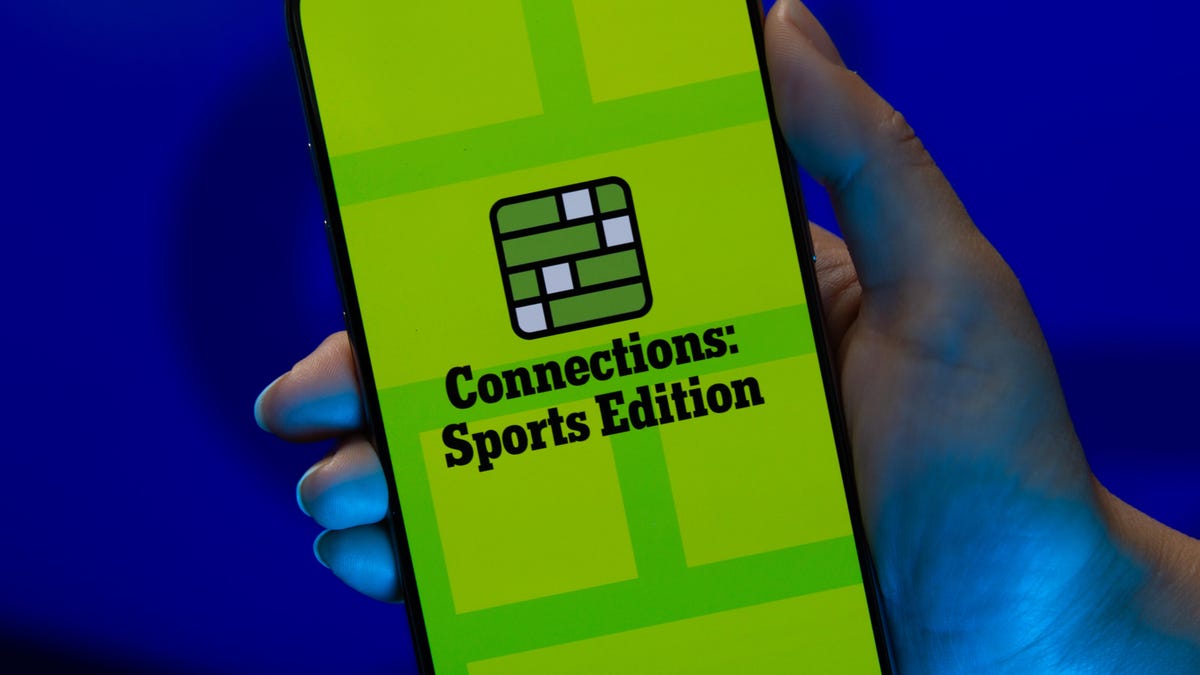
Looking for the most recent regular Connections answers? Click here for today’s Connections hints, as well as our daily answers and hints for The New York Times Mini Crossword, Wordle and Strands puzzles.
To solve today’s Connections: Sports Edition, focus on the endings of some of the words. That should help you see how they connect. Read on for hints and the answers.
Connections: Sports Edition is out of beta after making its debut on Super Bowl Sunday on Feb. 9. That’s a sign that the game has earned enough loyal players that The Athletic, the subscription-based sports journalism site owned by the Times, will continue to publish it. It doesn’t show up in the NYT Games app but now appears in The Athletic’s own app. Or you can continue to play it free online.
Read more: NYT Connections: Sports Edition Puzzle Comes Out of Beta
Hints for today’s Connections: Sports Edition groups
Here are four hints for the groupings in today’s Connections: Sports Edition puzzle, ranked from the easiest yellow group to the tough (and sometimes bizarre) purple group.
Yellow group hint: What you want to do.
Green group hint: Football abbreviations.
Blue group hint: Home to hoops.
Purple group hint: Hidden hockey team names.
Answers for today’s Connections: Sports Edition groups
Yellow group: Objective.
Green group: NFL teams, on scoreboards.
Blue group: NBA arenas ending with «Center.»
Purple group: Ends with an NHL team.
Read more: Wordle Cheat Sheet: Here Are the Most Popular Letters Used in English Words
What are today’s Connections: Sports Edition answers?
The yellow words in today’s Connections
The theme is objective. The four answers are aim, goal, mark and target.
The green words in today’s Connections
The theme is NFL teams, on scoreboards. The four answers are CHI, MIA, MIN and NO. (Chicago, Miami, Minnesota and New Orleans.)
The blue words in today’s Connections
The theme is NBA arenas ending with «Center.» The four answers are Barclays, Chase, Delta and Kia.
The purple words in today’s Connections
The theme is ends with an NHL team. The four answers are geoducks, spoilers, superstars and Vikings. (Ducks, Oilers, Stars and Kings.)
Technologies
Made by Google 2025: Everything Announced — Pixel 10, Pixel Watch 4, Pixel 10 Pro Fold
At a star-studded event hosted by late-night host Jimmy Fallon, Google announced new phones, watches, earbuds and Android features.
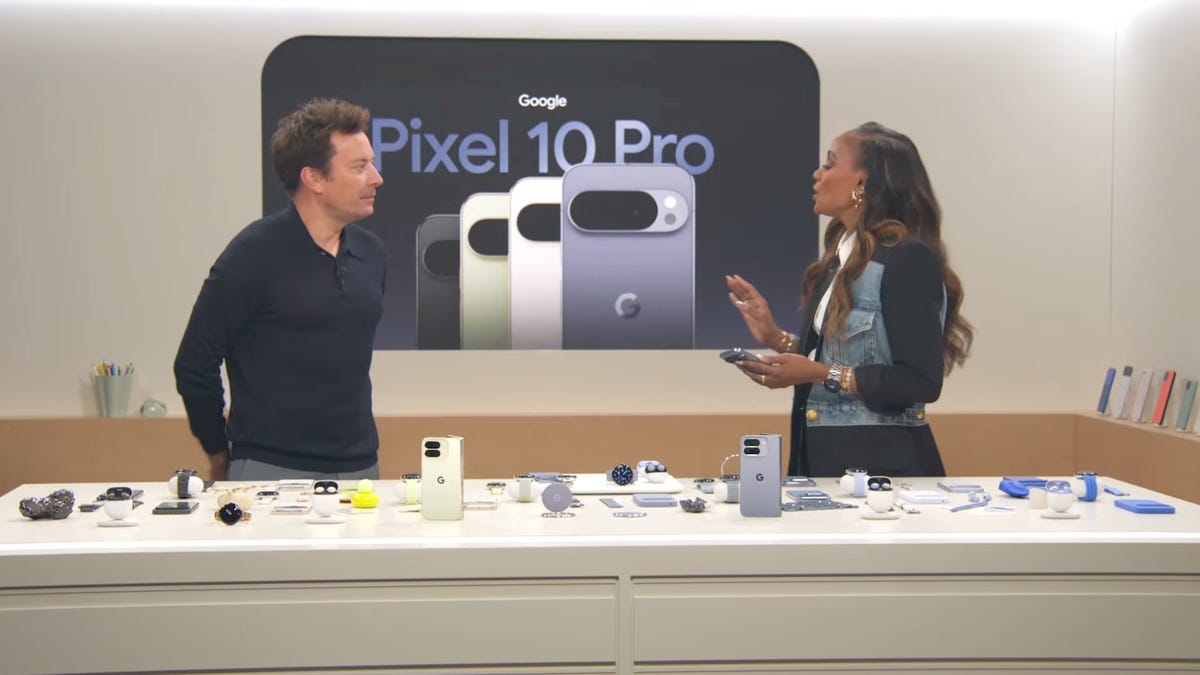
Even though the Pixel 10 leaks and rumors felt as if they arrived in a steady firehose before today’s Made by Google event — compelling the company to release a teaser video pre-announcing the new phone’s existence a month ago — Google still delivered details it somehow managed to keep private until it was ready to share.
And that delivery was refreshingly fun for a tech event. The Tonight Show host Jimmy Kimmel led the proceedings in a very late-night talk show format, bringing on several special guests from media, sports and yes, Google’s own experts to show off the products and features they’ve been working on for today’s announcements.
Pixel 10, Pixel 10 Pro and Pixel 10 Pro XL are real
Surprise, Google announced new phones! OK, this was the least surprising part of the event, but it still feels good to finally know what exists and when it’s coming. Preorders for the Pixel 10, Pixel 10 Pro and Pixel 10 Pro XL begin today and will be in stores and shipping starting August 28.
-
I’m Stoked That Google Made the Pixel 10 a $799 Value-Packed Feature Monster
-
I Tested Google’s Pixel 10 Pro XL in Paris, and I’m Impressed
-
Pixel 10 Pro and Pro XL First Look: Familiar Design, New AI Tricks
-
Google Launches the Full Pixel 10 Line, Including the Pixel 10 Pro and Pixel 10 Pro XL
Pixel 10 Pro Fold opens the next chapter of foldables
Folding phones so far have shared an Achilles Hinge: small particulates like sand can get inside the case and really mess things up. The Pixel 10 Pro Fold is one of the first to have an IP68 rating for dust and water resistance, meaning you can take it to the beach.
-
Pixel 10 Pro Fold Is Tougher, Smarter and Totally Dust Resistant
-
Forget the Pixel 10 Pro Fold. Foldables Should Look Like the Microsoft Surface Duo
-
Google’ Pixel 10 Pro Fold Is Here
Pixel Watch 4 talks to Gemini and is your new health coach
The Pixel Watch 4 includes new fitness options like real-time guidance while exercising. And if you forgot to start a workout, the watch (with AI help) can detect the activity in the background and remind you of it later, giving you credit for the effort you made. It’s also the only smartwatch that can detect a loss of pulse and call emergency services automatically.
-
Well Played, Google: The Pixel Watch 4 May Give Apple Watch Loyalists a Wandering Eye
-
Pixel Watch 4 First Look: Google Just Raised the Bar
-
The Pixel Watch 4 Is Here. Can It Finally Beat Apple?
Pixel Buds 2a are more affordable earbuds
Joining the Pixel Buds 2 Pro in the market are Pixel Buds 2a, an affordable ($130) pair of wireless earbuds that feature active noise cancellation, a smaller and lighter for all, and a twist-to-adjust stabilizer feature for setting a comfortable fit.
-
Google’s New Pixel Buds 2A Look a Lot Like the Pro 2, but Cost Way Less
-
Meet the Pixel Buds 2A: Google’s Budget Answer for ANC Buds
Pixel Buds Pro 2 owners will see new features
Coming in a software update next month, Pixel Buds Pro 2 owners will be able to answer calls or send them to voicemail with a nod or shake of the head. You’ll be able to talk to Gemini live in noisy locations, and benefit from adaptive audio that applies noise cancellation while letting important sounds come through. At the other end, a new feature will protect your hearing from very loud sounds.
Magic Cue is a Gemini assistant that pulls data from your correspondence
In the rollout of all the various AI technologies in the industry, the current stretch goal is «agentic» interactions with software: Having an AI that knows all sorts of details about you and can act to get the important stuff in front of you when needed. (And do it in a privacy-first way, one would hope.)
Magic Cue is Google’s implementation. It’s a new Gemini-based feature that can look through your earlier messages, emails and photos to pull details about things like restaurant reservations and flight times. Magic Cue runs on the Pixel device itself, so sensitive data stays private and not shared to the cloud.
A lot of Gemini AI intelligence is still coming soon
At the start of the event, Kimmell sat down in typical talk-show format with Rick Osterloh, senior vice president of platforms and devices, to chat about Gemini and the marvels of AI. Aside from Magic Cue, which will be shipping on the Pixel 10 phones, a lot of the features we’ve been hearing about are still on the horizon.
«For instance, Gemini could do something like plan a team celebration dinner for 12 people tonight,» he said. «It might go find a restaurant that’ll accommodate that group…. Look for a karoake place nearby and maybe even order custom T-shirts for the celebration.»
And when will that be possible? Kimmell asked. «A lot sooner than people think,» Osterloh replied. «This kind of thing is coming this year.»
The Pixel 10 Pro and 10 Pro XL can zoom to 100x with AI help
Pro Res Zoom on the Pixel 10 Pro phones pushes zooming far beyond what would seem to be possible with typical small cameras. Usually when you zoom beyond the optical limits of the cameras, details get fuzzy as the software upscales the image. With Pro Res Zoom, when you go beyond 30x zoom, it uses generative AI to build a sharper version. CNET’s Andrew Lanxon got both impressive and head-scratching results while making photos in Paris using the Pixel 10 Pro XL.
Camera Coach uses AI to encourage better photos
Smartphone cameras have employed AI for several years, such as identifying subjects in order to blur the background for Portrait modes or quickly snapping several shots at multiple exposures and blending them together to create well-balanced lighting throughout. Now Google is using AI to help you take better photos.
Camera Coach is a new feature in the Pixel Camera app that looks at the scene in front of the lens and generates multiple suggestions for how to improve the photo before it’s captured. To show this off, podcaster Alex Cooper brought Fallon out to be her model and sat him down on a couch. When she activated the feature, Camera Coach suggested that she move the camera closer to the subject, position his head in the upper portion of the frame, lower the camera to eye level and turn on Portrait mode.
«To all the girls that are watching, I personally know how hard it is to train your boyfriend or your husband to get that perfect shot,» said Cooper. «And now Camera Coach can just train all the boys for us.»
Pixel 10 supports Qi2 magnetic charging
The Qi2 spec includes not just faster charging but also an array of magnets on the back for connecting to accessories. Sound familiar? The presenters mentioned Apple’s MagSafe system, then paused with the realization that they probably shouldn’t have name-checked it during the Google event. On the Pixel 10 phones, it’s called Pixelsnap and should work with accessories made for Apple’s ecosystem too.
Pixel 10 will be available in Mexico
In an impressive segment demonstrating Gemini live translation during a phone call, musician Karen Polinesia, who speaks Spanish, announced that for the first time, the Pixel 10 will be available for sale in Mexico.
This article is being updated; stay tuned for more.
Technologies
Upgrading to Pixel 10? Here’s How to Prepare Your Old Pixel for Trade-In
Don’t send off your phone with a ton of personal information still on it.
Google just announced the Pixel 10 family, and several preorder offers are available right now. If you’re looking for an even better deal on these new phones, you might want to consider trading in your old Pixel for maximum savings.
The Pixel 10 family consists of the base Pixel 10 model, two Pro models and the latest Pro Fold. All of these phones feature the latest Tensor G5 Processor, Qi2 wireless charging and, of course, new AI tricks. We went hands-on with the new phones, and they made a good impression.
If you’re ready to leap into a new Pixel, you’ll want to make sure you’ve prepared your old phone properly before you send it off.
If you don’t check all the right boxes for trading in your phone, its trade-in value could be reduced. You also want to avoid sending your phone out with a ton of personal information still left on it.
Below, we’ll go over the steps to ensure a seamless trade-in experience when your new Pixel 10 arrives.
For more, we’ve wrangled all of the best Pixel 10 cases you can buy right now.
Turn off the activation lock on your Pixel phone
Before you trade in your phone, you’ll just need a factory reset to qualify for the maximum trade-in value. Some retailers want you to remove the activation lock from your phone first, which requires removing the device from your Google account before resetting it. (AT&T took off over $400 of the value because I didn’t do this to my Pixel 7 Pro when I upgraded to the 8 Pro a few years back.)
You can remove your Google account from your phone directly or via your online account.
From your Pixel settings
You can remove the activation lock right from your Pixel phone. H:
- On your phone, navigate to Settings.
- Tap Passwords & accounts.
- Tap your Google account.
- Tap Remove account.
Repeat this process for any additional accounts you need to remove.
From the web
Alternatively, you can head to your online Google account web page and handle the removal from there.
- From a web browser, navigate to your Google account.
- Select Security on the left sidebar.
- Locate the Your devices box, and select Manage all devices.
- Select the device you’re trading in.
- Select Sign out.
Factory reset your Pixel
With the activation lock removed, you’re now free to factory reset your device as you normally would.
- On your Pixel, navigate to Settings.
- Tap System.
- Tap Reset options.
- Tap Erase all data (factory reset).
That’s it. Now you’re ready to send in your trade-in without any hiccups that could drop the value you get for your phone.
For more, check out a closer look at the Pixel 10 Pro XL’s camera performance.
-

 Technologies3 года ago
Technologies3 года agoTech Companies Need to Be Held Accountable for Security, Experts Say
-

 Technologies2 года ago
Technologies2 года agoBest Handheld Game Console in 2023
-

 Technologies2 года ago
Technologies2 года agoTighten Up Your VR Game With the Best Head Straps for Quest 2
-

 Technologies4 года ago
Technologies4 года agoVerum, Wickr and Threema: next generation secured messengers
-

 Technologies4 года ago
Technologies4 года agoGoogle to require vaccinations as Silicon Valley rethinks return-to-office policies
-

 Technologies4 года ago
Technologies4 года agoBlack Friday 2021: The best deals on TVs, headphones, kitchenware, and more
-

 Technologies4 года ago
Technologies4 года agoOlivia Harlan Dekker for Verum Messenger
-

 Technologies4 года ago
Technologies4 года agoiPhone 13 event: How to watch Apple’s big announcement tomorrow

